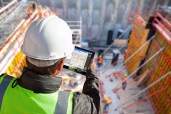Applications and techniques for tilt-up construction continue to expand. Keeping up is critical for success and one of the best ways to do that is at the Tilt-Up Convention and Exposition sponsored by the Tit-Up Concrete Association (TCA); Concrete Construction is the official media sponsor of the event. This year’s show is Sept. 19 to 21 in Dallas.
One unique feature this year is the Solutions Sandbox: 13 stations with small-group presentations and live demonstrations. TCA attempted this two years ago, where everything demonstrated was a solution to a real jobsite issue. This year’s demos have a mix of ideas embracing this same mission. The products are meant to help designers and contractors increase productivity and quality.
Here are three solutions we found particularly interesting. See the box for a list of the other 10 demos. Click here to register for the 2018 Tilt-Up Convention & Expo.
Tilt-up Panel with Helix Reinforcement

Tilt-Up Concrete Association
Helix micro rebar and CTS Rapid Set Cement will combine to produce a panel that can be placed and lifted in one day with minimal conventional reinforcing steel.
“This may be the most exciting demo because it will include an actual lift and has additional interest due to the use of high-early strength concrete and twisted steel micro rebar,” says TCA Technical Director Jim Baty.
The planned panel will be 25 feet tall, 16 feet wide, and erected the day it’s poured. The majority of the reinforcement will be provided by Helix Steel’s twisted steel micro rebar (TSMR), a 3D technology that increases shear strength, durability, ductility, and pre-crack capabilities. This panel will push the envelope of what’s possible being thinner and having no other traditional reinforcement.
The mix will incorporate CTS Cement’s Fast Rock 500, which transforms ready-mix concrete into a rapid-setting mix when substituted for a small percentage of the portland cement. This allows the panel to be erected in as little as 6 hours. Flexural testing will be used to ensure panels reach the required capacity before erection.
Helix TSMR is high tensile strength steel wire with a rectangular cross section. Fibers are 1 inch long and have an equivalent diameter of 0.02 inch. There are more than 11,000 fibers in each pound. Helix will be mixed into the concrete at a rate of 45 pounds per cubic yard. In tests with CTS’ Cement All, the mix reached a flexural strength of 1,260 psi. “We’ve worked with CTS Cement in the past,” says Helix Founder and President Luke Pinkerton, “and have found a synergistic effect when these two materials are used together.” Fast Rock 500 isn’t identical to Cement All, but is based on the same active ingredient.
A second panel that uses conventional concrete along with Helix providing the majority of the reinforcement without thickness reduction will also be erected after five days.
During the demonstration, the panels will be lifted and placed on piers. Visitors will be able to witness lifting and bracing.
The Tiltup Brace Saddle

GHC Products Inc
The TiltUp Brace Saddle allows for easy and safe removal of panel braces.
Introduced at 2018 World of Concrete, this clever new device makes removing braces simple and safe. “We used to remove them with a manlift and a rope,” says Greg Carpenter, inventor and president of Greg Carpenter Concrete, a union shop, full-service concrete contractor based in Lodi, California. With braces weighing as much as 300 pounds, this can create a difficult and dangerous situation.
The Tiltup Brace Saddle attaches to the forks of a vertical forklift or telescopic forklift (telehandler). Pockets on the mechanism line up and are tied with a safety chain to the forklift. With a capacity of 700 pounds, the saddle can remove the heaviest braces with ease. Once the roof diaphragm is in place to stabilize tilt-up panels, a three-worker team armed with the saddle goes to work. After removing the floor bolt from the foot of the brace, one worker positions the saddle in the middle of the brace while another in a manlift removes the bolt holding the brace to the wall. The forklift backs up while a third worker holds the foot of the brace to swing it to a horizontal position for stacking and eventually removal from the jobsite.
The mechanism has no power; it’s basically an axle the brace swivels around. The saddle includes a ratcheting nylon safety strap for use on rough terrain; although if the brace is reasonably centered on the saddle, the strap isn’t really needed on concrete floors or casting slabs. The worker on the ground can easily control the end of the brace with the forklift supporting all the weight.
Visitors to this demonstration will have the chance to handle a brace, which will be in the saddle, to see how easy it is to maneuver.
This is just the latest product for tilt-up construction Carpenter has invented. Others include an adjustable support chair, a plastic device to hold expansion joints in position during placement, a tape dispenser for taping the seams in under-slab vapor barriers, and a pipe dowel for simple stabilizing of slab joints.
Go to ghcproducts.com to see a video of the product in action before its debut at the Solutions Sandbox.
Solutions Sandbox
In addition to the demonstrations from Helix/CTS Cement, GHC Products, and Trimble, there will be 10 other demonstrations at the show in Dallas. At each station, the exhibitor will demonstrate a solution to a defined problem or hurdle in the tilt-up industry.
Reveal Comparison: This interactive display will demonstrate proper installation practices for reveal products, highlight the differences between reveal types, and show the impact of reveal selection on the finished product. Sponsored by Nox-Crete
Rebar Tying Competition: Contestants will take turns tying cages and competing for prizes. Sponsored by MaxUSA Corp.
Thermal Break Detailing for Insulated Panels: A typical issue for insulated panels is how to detail the insulation into the window and door jamb. This display will include both a formed condition and a small in-place sample panel. Sponsored by TigerLoc
Proper Curing of Slabs for Tilt-Up: This demonstration will guide participants in how to cure a slab that will have a tilt-up panel constructed on top. Visitors will have the opportunity to apply various curing materials and bondbreakers. Sponsored by SpecChem
Attachment of Brace to Helical Anchor: At this demonstration, a braced panel secured from the back side will allow visitors to attach and detach a brace without removal of the brace shoe. Also demonstrated will be the installation of a base connection grout bar on a footing with no slab. Sponsored by SureBuilt Concrete Forms & Accessories
Repair Patch: Visitors to this demonstration will have the opportunity to use two rapid-setting repair products to patch holes in a tilt-up panel. Sponsored by CTS Cement
Form Layout for Brick Liner: Visitors to this demo will be able to lay out a form for an adjusted brick liner for window openings. Sponsored by Innovative Brick Systems
Installation of Tilt-Up Anchor: Participate in positioning an anchor assembly that will show how it provides clean cover of the anchor and quick attachment for lifting a panel. Sponsored by Dayton Superior
Quick Connect Helical Ground Anchor: This display will demonstrate the quick connection of a brace to a helical ground anchor as well as the time savings of the panel/footing connection. Sponsored by Connect-EZ
Innovative Tilt-Up Hardware: New and solution-oriented products will be on display. Sponsored by Meadow Burke/Thermomass
Tech for Tilt

Tilt-Up Concrete Association
The Trimble Hololens Hardhat superimposes the structure’s design onto the real structure.
Technology is driving the industry forward and Trimble wants attendees to be able to see, touch, and interact with the technology that’s changing the way the world works. This demonstration will show how tilt-up designers and contractors can use technology solutions to maximize efficiency and profitability while also improving project quality.
Visitors to this demonstration will go through a mini-lifecycle example from estimation and bidding through placement. Each participant will get to interact with a 3D constructible model in Tekla Structures, live project status sharing in Trimble Connect (an agnostic information-sharing platform), mixed reality with Microsoft Hololens adapted into a hardhat, and layout and QA/QC with a Trimble Robotic Total Station.
First, a constructible 3D model will be used to generate accurate quantities for estimation to reduce risk during bidding and ensure the project can be built efficiently in terms of time, cost, and safety. Large screens will allow attendees to see how the quantities are developed for the estimate as well as how to speed up and improve the development of panel drawings.
Next, visitors will learn how to develop panel drawings from the model and then send layout point data to a robotic total station. Making mistakes on these points can lead to costly and time-consuming rework, but matching the model to the total station eliminates errors and allows information to be returned from the total station back to the model for QA/QC. A 4-foot-by-6-foot tilted panel and a Trimble Robotic Station will allow attendees to see how to send the data to the field and to view layout points from the model on a hand-held tablet that can be used to do single-person layout in the field.
Finally, Trimble will show how technology is taking construction to the next level with mixed reality: a technology that merges real and virtual worlds to create an environment where physical and digital components interact in real time. It’s “mixed” reality because it encompasses both augmented/virtual reality and the real world via immersive technology, letting you see the real environment overlaid with holographic data from a 3D model.
The same data-driven, constructible model will be exported to a Microsoft Hololens built into a hard hat. Visitors will walk around the tilted panels wearing the Hololens to verify placement of anchors. Also, as these layout points and concrete are being placed, Trimble representatives will demonstrate a live status-sharing capability between Trimble Connect and Tekla Structures. To see how this works, watch one of these videos.



